Lost and Found...
 Adelle Hasford
Adelle HasfordImagine you just finished giving a presentation on the benefits of using AWS cloud services as opposed to maintaining on-prem locations. You join in the networking session go around different places, and then head back to your office. Now, you are thinking of getting lunch and reaching out for your phone. But it is nowhere to be found. So, how do you backtrack to find your missing gadget?
Problem
With the advancement of technology, a fast-paced lifestyle has arisen to support the needs of growing populations. With the increased busyness comes an increase in the issue of lost items. This problem, is expensive in both time and money (Tan & Chong, 2023).
For this project, we focus on Ashesi University and like most other universities, it has a lost and found collection point for student and staff to claim their belongings. However, many members remain unaware of these locations and other tools employed (RepoApp, 201). The growing university community and environment make it unfeasible to search for lost items on-premises physically.
Before delving into the solution, we shall dive into the current system in place for this.
How does Ashesi track lost and found items
Reporting lost items
Students/staff need to submit a form with the following details
Personal information: full name, school email and phone number
Item details: name, details and any additional context
Last seen: location, time and event
Users may also upload a picture of the lost item to help speed up the search process.
Student welfare chairpersons (or staff officers) then broadcast an email to the university population concerning the missing item.
Reporting found items
Students/staff can drop off the item at one of the collection points; usually the case for random objects
The finder can hand it over to the authorities (library officer, coordinator or student welfare officer), which is usually the case for expensive items.
Reply to the email concerning the lost item and report the missing item found, or contact the student welfare chairperson directly.
Retrieving lost but found items
Meet the officers for identification for identification and collection
Go to the collection point and retrieve the item
Student welfare chairs contact the reporter of the missing item
The process outlined above is the traditional method utilised by Ashesi University and involves manual record-keeping and cumbersome retrieval processes. Officers need to match reports of found items to reports of lost items before reaching out to facilitate the return of these items. These systems lead to the inefficiencies and delays in item recovery.
Hence, there is a need to find an efficient way to retrieve these lost items. The wide spread of technology makes it possible to utilise new methods to facilitate lost-and-found tracking. By leveraging AWS's robust infrastructure, we can develop a more efficient and automated system to track and recover lost items, reducing the number of unclaimed belongings and helping users quickly locate their property.
Proposed Solution
The proposed solution utilises AWS services to produce a simple web app that users may interact with.
Core Features
User Submission – Users can submit reports for lost and found items.
Matching System – Automatically match lost items with found reports based on keywords, date, and location.
Notifications – Notify users when a match is found.
AWS Service Breakdown
S3 – Store lambda functions and cloud formation templates
DynamoDB – Store reports and user info
API Gateway + AWS Lambda – Handle API requests for item submissions, matches, claims, and notifications.
CloudFormation – Automate infrastructure setup.
SNS – Send email notifications for matches and claims
Here’s a basic run down of how the proposed system would work:
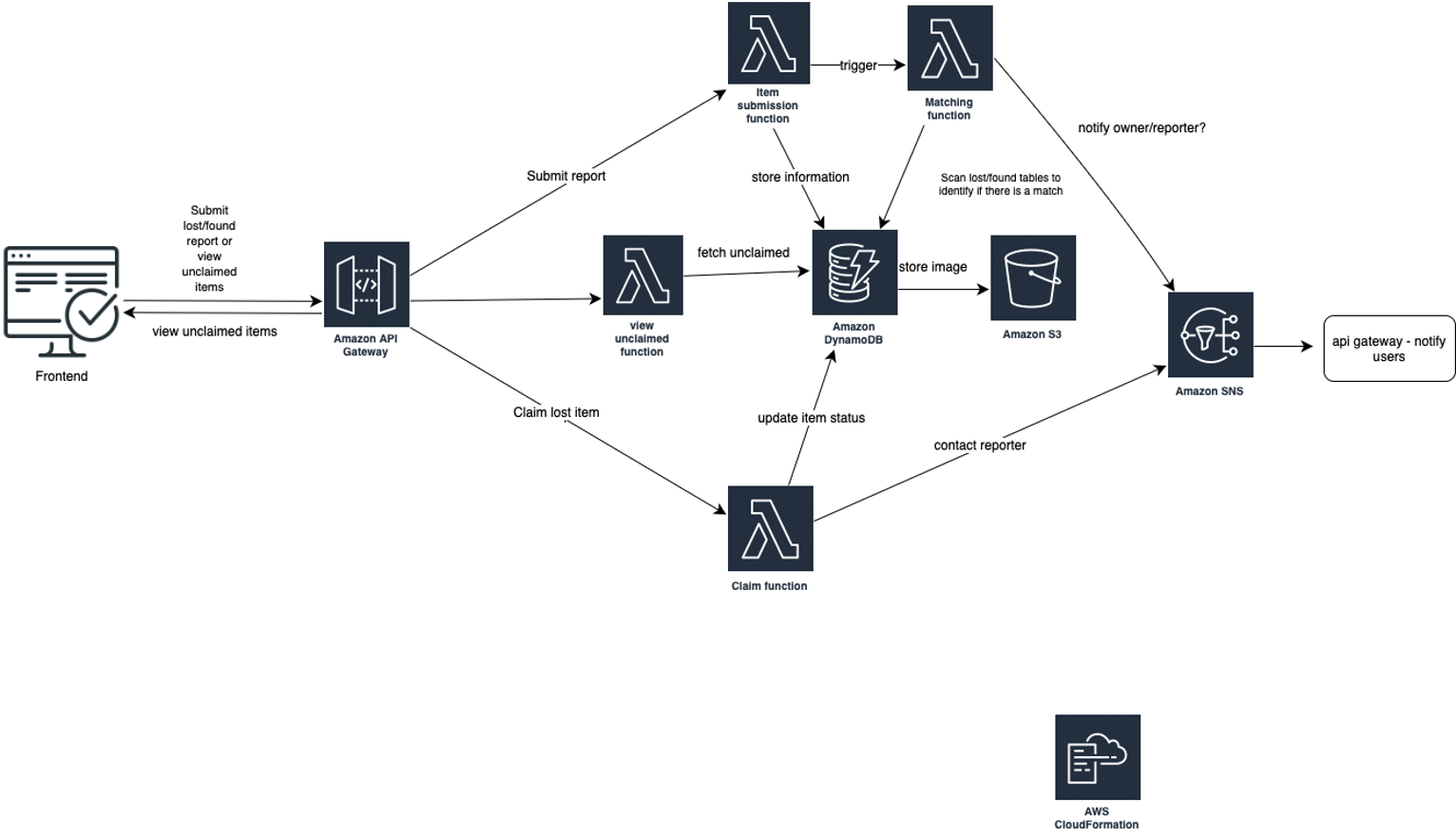
Implementation
For this project, we will use AWS CloudFormation to help with the quick deployment and re-usability.
To create a stack:
Navigate to AWS management console > CloudFormation
Navigate to Stacks in the pane
Create Stack
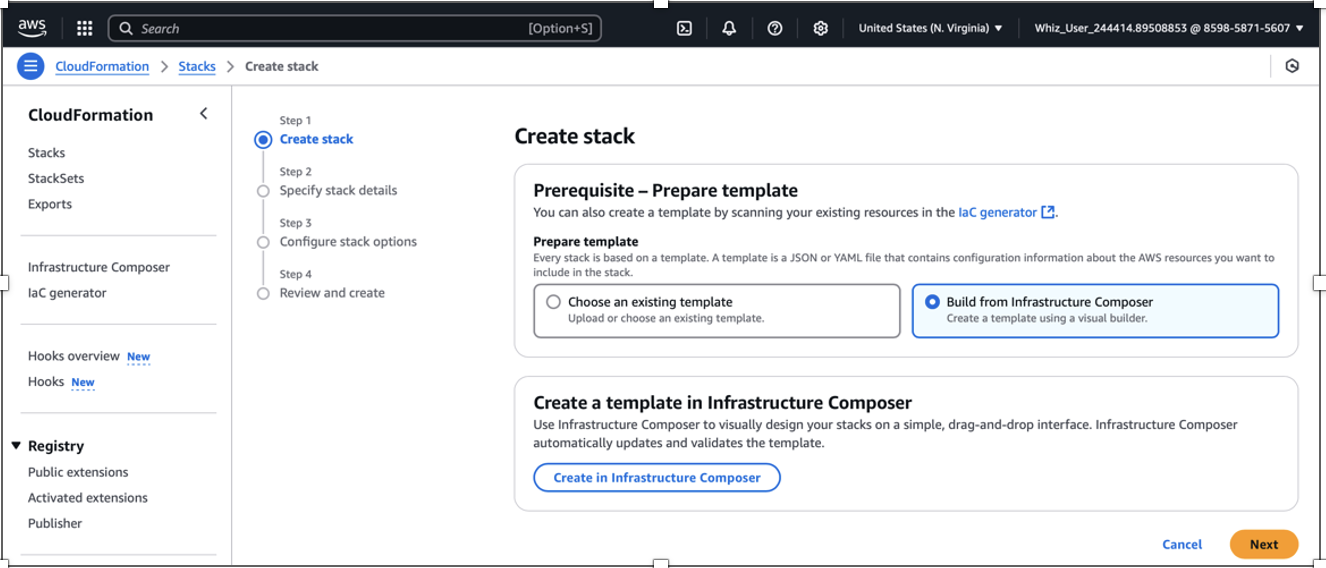
Select
Create in Infrastructure composerNavigate to
templateon the canvasCopy the contents of this yaml file → this creates the tables we will be using for the project
AWSTemplateFormatVersion: '2010-09-09'
Description: CloudFormation template for API Gateway, Lambda, and DynamoDB for the Lost & Found Item Tracker
Resources:
# DynamoDB Table
LostAndFound:
Type: 'AWS::DynamoDB::Table'
Properties:
TableName: 'LostandFound'
AttributeDefinitions:
- AttributeName: report_id
AttributeType: S
BillingMode: PAY_PER_REQUEST
KeySchema:
- AttributeName: report_id
KeyType: HASH
StreamSpecification:
StreamViewType: NEW_AND_OLD_IMAGES
DependsOn: LambdaExecutionRole
# Users Table
Users:
Type: 'AWS::DynamoDB::Table'
Properties:
TableName: 'Users'
AttributeDefinitions:
- AttributeName: user_id
AttributeType: S
BillingMode: PAY_PER_REQUEST
KeySchema:
- AttributeName: user_id
KeyType: HASH
DependsOn: LambdaExecutionRole
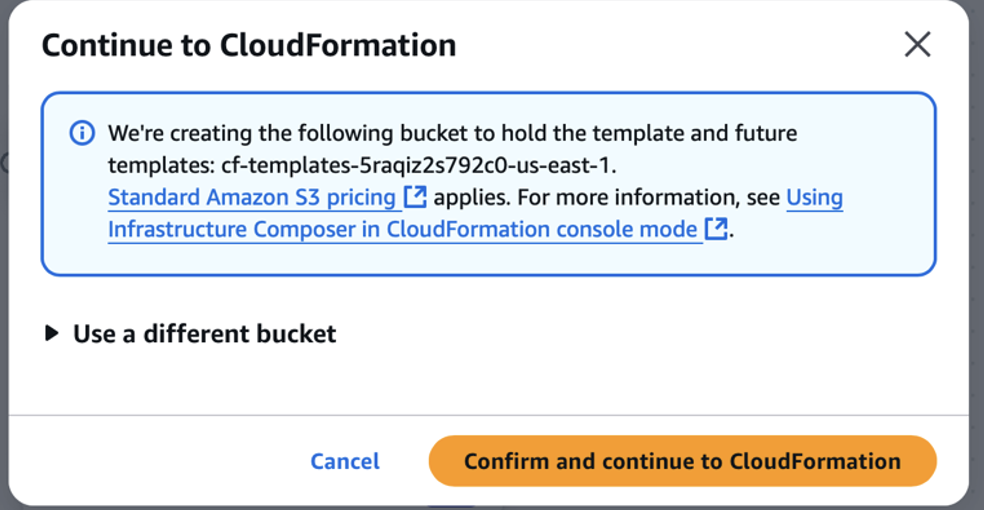
Provide a stack name.
Under configure stack options, set deletion policy to delete all regardless of the retention policy.
Acknowledge all the necessary items in capabilities and transform and then create.
A successful creation appears with this message:
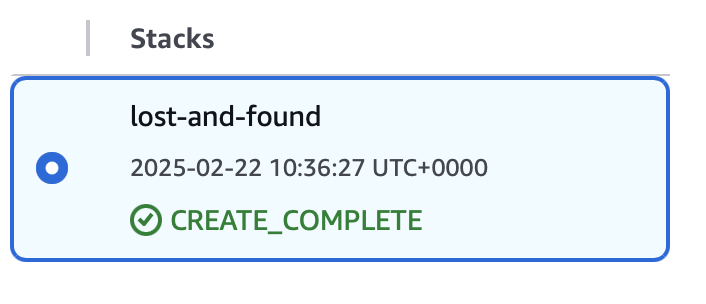
Lambda functions
In this project, we have 3 main lambda functions
Reports Lambda: This function manages reports' creation, retrieval, and claiming. Users can create a lost or found report. Retrievals handle the logic of returning only lost items; with claims, users are notified when a successful claim is made.
Matching Lambda: This function manages the logic for when a match between lost and found reports is made and notifies the user. It uses fuzzy logic to match reports based on name and description.
Users Lambda: This function manages the creation and retrieval of users. It serves as a basic version of an API instead of using AWS Cognito. It is also responsible for subscribing users to the SNS topic
The code for each of these functions can be found below.
NB: the header part in the response is due to CORS enabling which we will talk about later
# REPORT LAMBDA
import boto3
import json
import uuid
import datetime
import os
dynamodb = boto3.resource('dynamodb')
table = dynamodb.Table('LostandFound')
sns_client = boto3.client('sns')
SNS_TOPIC = os.getenv('NOTIFS')
# handling reports
def lambda_handler(event, context):
http_method = event['httpMethod']
path = event['path']
if http_method == 'POST' and path == '/reports':
return create_report(event)
elif http_method == 'GET' and path == '/reports':
return get_reports(event)
elif http_method == 'PATCH' and path.startswith('/reports/'):
return make_claim(event)
else:
return {
'statusCode': 404,
"headers": {
"Access-Control-Allow-Origin": "*",
"Content-Type": "application/json"
},
'body': json.dumps('Invalid route')
}
def create_report(event):
body = event['body'] if isinstance(event['body'], dict) else json.loads(event['body'])
reportId = str(uuid.uuid4()) # random unique id
user_email = body.get('reported_by')
item_name = body.get('name')
item_description = body.get('description')
item_location = body.get('last_seen')
item_status = body.get('item_status') # track if it's a lost or found report
item = {
'report_id': reportId,
'reported_by': user_email,
'name': item_name,
'description': item_description,
'last_seen': item_location,
'item_status': item_status,
'created_at': str(datetime.datetime.now())
}
table.put_item(Item=item)
return {
'statusCode': 200,
"headers": {
"Access-Control-Allow-Origin": "*",
"Content-Type": "application/json"
},
'body': json.dumps('Item created successfully')
}
def get_reports(event):
response = table.scan(
FilterExpression="item_status = :status",
ExpressionAttributeValues={":status": "lost"}
)
return {
"statusCode": 200,
"headers": {
"Access-Control-Allow-Origin": "*",
"Content-Type": "application/json"
},
"body": json.dumps(response["Items"])
}
def make_claim(event):
reportId = event['pathParameters']['report_id']
body = event['body'] if isinstance(event['body'], dict) else json.loads(event['body'])
user_email = body.get('user_id')
send_claim_notif(reportId, user_email)
# Update report status to 'claimed'
table.update_item(
Key={'report_id': reportId},
UpdateExpression='SET item_status = :status',
ExpressionAttributeValues={':status': 'claimed'}
)
return {
"statusCode": 200,
"headers": {
"Access-Control-Allow-Origin": "*",
"Content-Type": "application/json"
},
"body": json.dumps({"message": "Report status updated to claimed"})
}
# set up SNS function to notify users
def send_claim_notif(report_id, user_email):
response = table.get_item(Key={'report_id': report_id})
report = response['Item']
sns_message = (
f"Your {report['item_status']} item report from {report['created_at']}\
has been claimed by user {user_email}\n"
f"Please contact the claimant to verify and take further action. .\n\n"
f"Item Details:\n"
f"Name: {report['name']}\n"
f"Description: {report['description']}\n"
f"Last Seen: {report['last_seen']}\n"
)
sns_client.publish(
TopicArn=SNS_TOPIC,
Message=sns_message,
Subject="Report Claimed",
MessageAttributes={
'user_id': {'DataType': 'String', 'StringValue': report['reported_by']}
}
)
# MATCHING LAMBDA
import boto3
import json
import string
import os
from thefuzz import fuzz
dynamodb = boto3.resource('dynamodb')
table = dynamodb.Table('LostandFound')
sns_client = boto3.client('sns')
SNS_TOPIC = os.getenv('NOTIFS')
# handling matches
def lambda_handler(event, context):
# process new reports
for record in event['Records']:
if record['eventName'] == 'INSERT':
new_report = record['dynamodb']['NewImage']
best_match = find_best_match(new_report)
if best_match:
# set up SNS for notifying users
print(f"Best match found: {best_match}")
send_match_notif(best_match, new_report)
return {
"statusCode": 200,
"body": json.dumps("Match process completed")
}
def preprocess_text(text):
if not text:
return ""
text = text.lower()
text = text.translate(str.maketrans('', '', string.punctuation))
return text.strip()
def find_best_match(new_report):
item_status = new_report["item_status"]["S"]
if item_status not in ["lost", "found"]:
return None
# determine opposite status for matching
target_stats = "found" if item_status == "lost" else "lost"
# retrieve reports with target stats
response = table.scan(
FilterExpression="item_status = :status",
ExpressionAttributeValues={":status": target_stats}
)
reports = response.get("Items", [])
if not reports:
return None
best_match = None
best_score = 0
for report in reports:
score = compute_match_score(new_report, report)
if score > best_score:
best_score = score
best_match = report
return best_match if best_score > 80 else None
def compute_match_score(new_report, old_report):
# preprocess both reports
newr_name = preprocess_text(new_report["name"]["S"])
newr_desc = preprocess_text(new_report["description"]["S"])
oldr_name = preprocess_text(old_report.get("name", ""))
oldr_desc = preprocess_text(old_report.get("description", ""))
# calculate fuzz ratio for name and description
name_score = fuzz.token_sort_ratio(newr_name, oldr_name)
desc_score = fuzz.token_set_ratio(newr_desc, oldr_desc)*0.65 + fuzz.partial_ratio(newr_desc, oldr_desc)*0.4
return (name_score*0.4) + (desc_score*0.5)
def send_match_notif(match, original):
sns_message = (
f"We found a potential match! Please contact {match['reported_by']} to verify and take further action. .\n\n"
f"Your Report:\n"
f"Item: {original['name']['S']}\n"
f"Description: {original['description']['S']}\n"
f"Last Seen: {original['last_seen']['S']}\n\n"
f"Matched Report:\n"
f"Item: {match['name']}\n"
f"Description: {match['description']}\n"
f"Last Seen: {match['last_seen']}\n\n")
response = sns_client.publish(
TopicArn=SNS_TOPIC,
Message=sns_message,
Subject="Potential Match Found",
MessageAttributes={
'user_id':{'DataType': 'String', 'StringValue': original['reported_by']['S']}
}
)
print(f"Notification sent, message ID: {response['MessageId']}")
# USERS LAMBDA
import boto3
import json
import os
import datetime
dynamodb = boto3.resource('dynamodb')
table = dynamodb.Table('Users')
sns = boto3.client('sns')
SNS_TOPIC = os.getenv('NOTIFS')
# lambda function to handle user details
def lambda_handler(event, context):
http_method = event['httpMethod']
path = event['path']
if http_method == 'POST' and path == '/users':
return create_user(event)
elif http_method == 'GET' and path.startswith('/users/'):
return get_user(event)
else:
return {
'statusCode': 404,
"headers": {
"Access-Control-Allow-Origin": "*",
"Content-Type": "application/json"
},
'body': json.dumps('Invalid route')
}
def create_user(event):
body = event['body'] if isinstance(event['body'], dict) else json.loads(event['body'])
user_email = body.get('user_id')
user_name = body.get('name')
# check if the user already exists
if check_user_exist(user_email):
return {'statusCode': 400, 'body': json.dumps('User already exists')}
user = {
'user_id': user_email,
'name': user_name,
'created_at': str(datetime.datetime.now())
}
table.put_item(Item=user)
subscribe_user(user_email)
return{
'statusCode': 200,
"headers": {
"Access-Control-Allow-Origin": "*",
"Content-Type": "application/json"
},
'body': json.dumps('User created successfully')
}
def check_user_exist(user_email):
response = table.get_item(Key={'user_id': user_email})
return 'Item' in response
def get_user(event):
user_email = event['pathParameters']['user_id']
response = table.get_item(Key={'user_id': user_email})
if 'Item' not in response:
return {"statusCode": 404, "body": json.dumps("User not found")}
else:
return {"statusCode": 200, "body": json.dumps(response['Item'])}
def subscribe_user(user_email):
try:
# subscribe user to SNS topic
print('Subscribing user: ', user_email)
response = sns.subscribe(
TopicArn=SNS_TOPIC,
Protocol='email',
Endpoint=user_email,
Attributes={"FilterPolicy": json.dumps({"user_id": [user_email]})}
)
print(f"Subscribed user: {user_email}")
except Exception as e:
return {"statusCode": 500,
"headers": {
"Access-Control-Allow-Origin": "*",
"Content-Type": "application/json"
},
"body": json.dumps(str(e))}
So, to utilise these functions and deploy them with our cloudformation template, we need to zip each function (and any dependencies they may need) and upload them into an s3 bucket.
Navigate to s3 on the console
Create a bucket
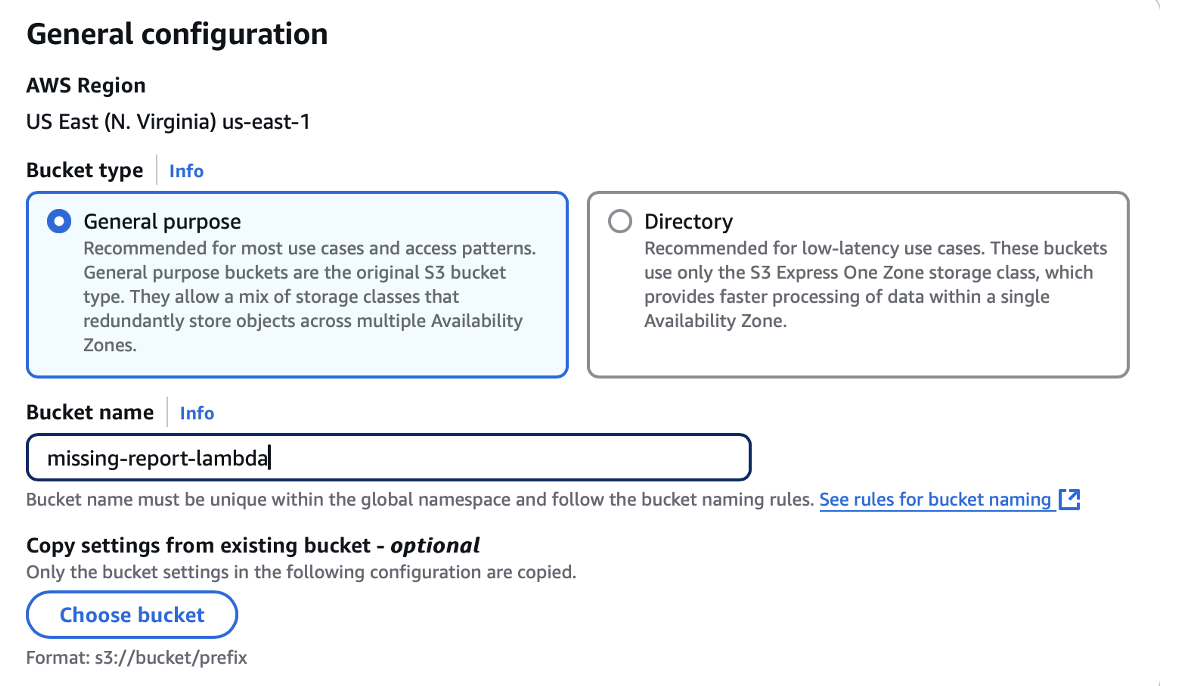
Leave all other settings at default and click Create
Double-click the selected bucket’s name and upload the files into it
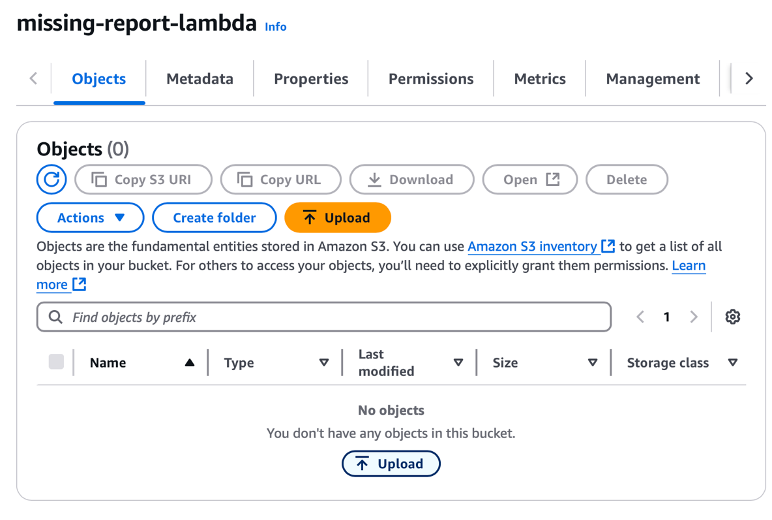
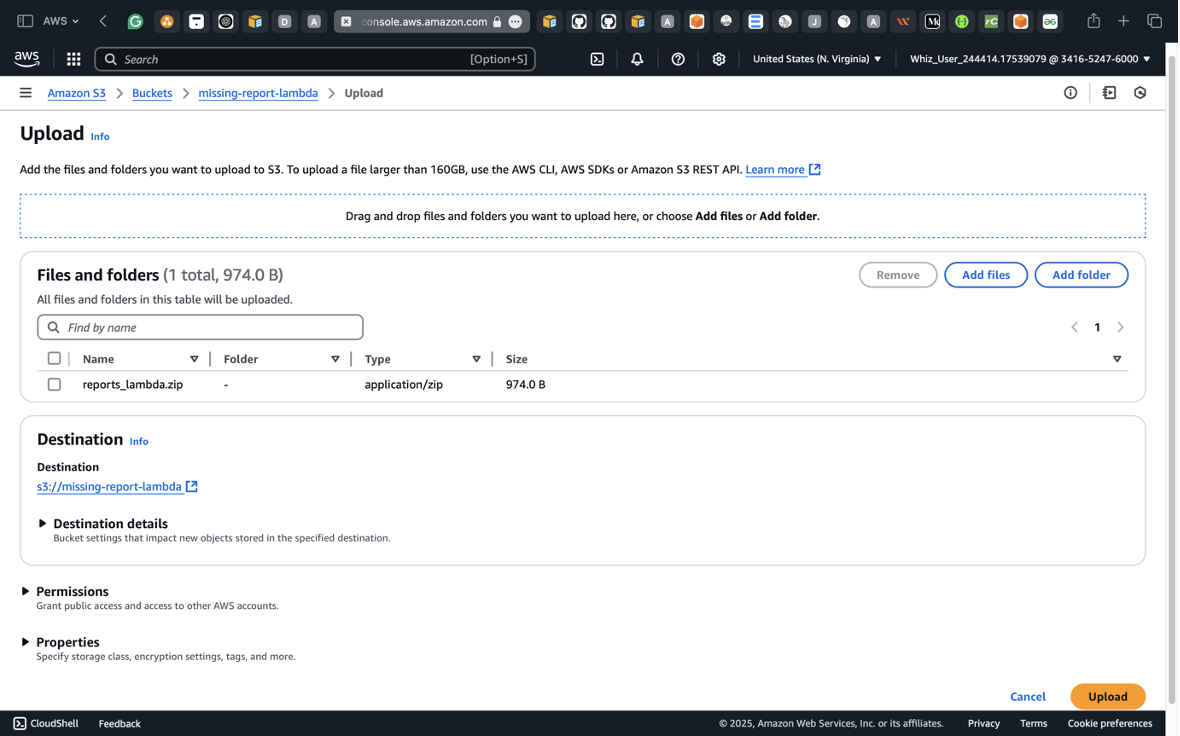
- Click upload and then proceed
Next we want to go ahead and update our cloud formation template
- Click on update and edit in infrastructure composer
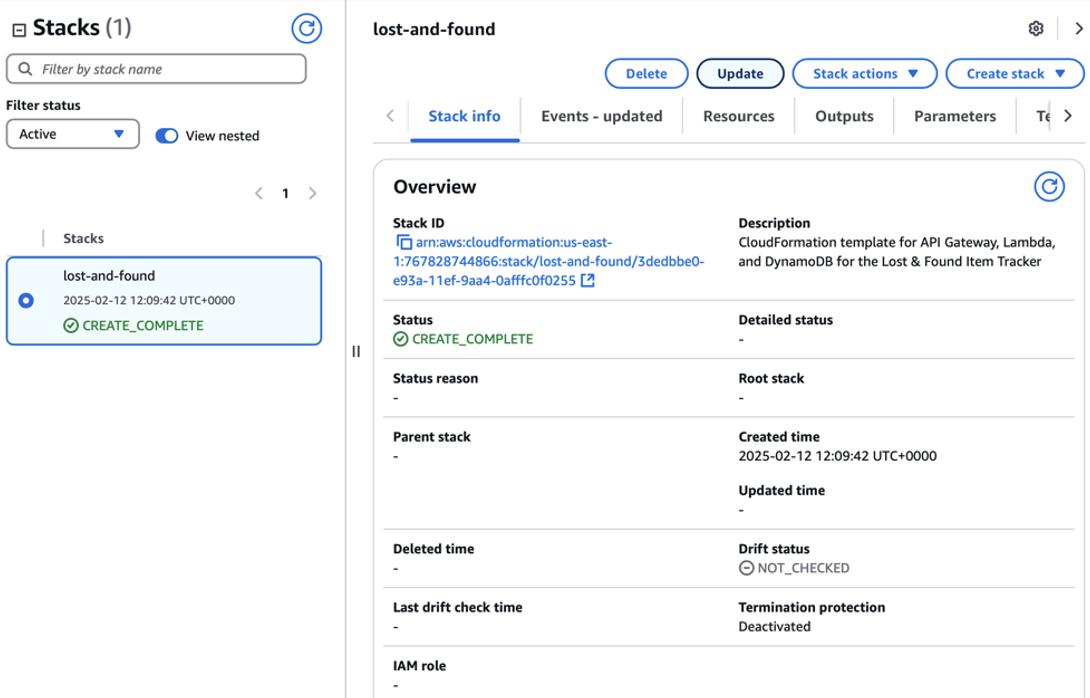
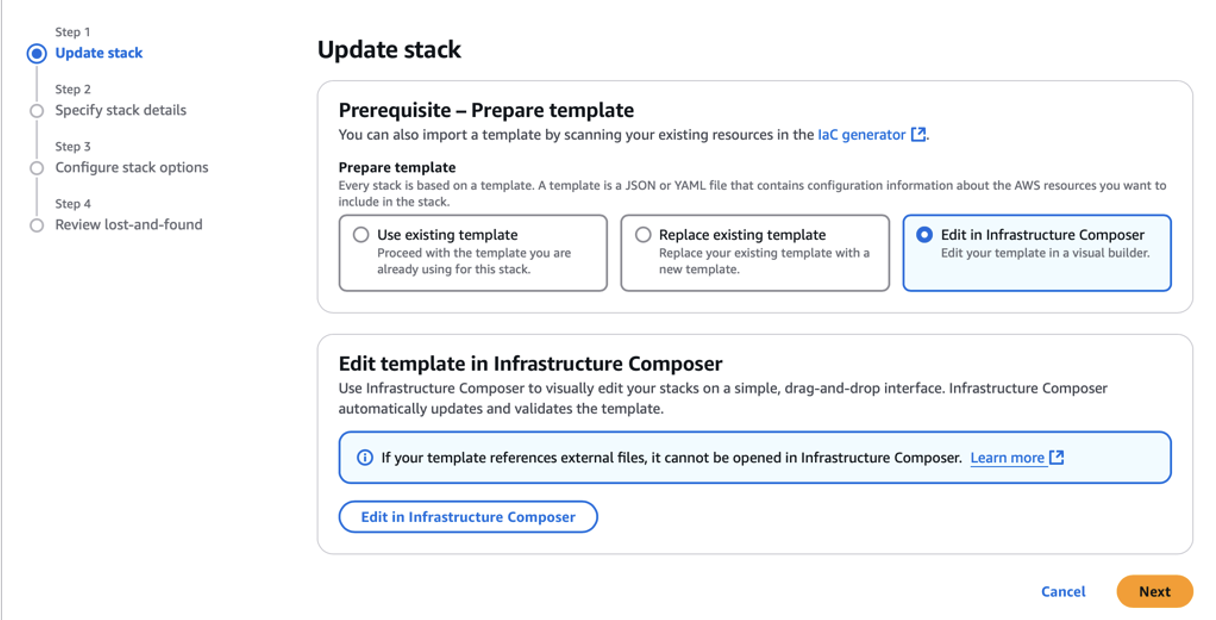
Next edit in the template part of the canvas and validate
Copy and paste this code
# Iam role for lambda - access DynamoDb, cloudwatch logs and sns
LambdaExecutionRole:
Type: 'AWS::IAM::Role'
Properties:
AssumeRolePolicyDocument:
Version: "2012-10-17"
Statement:
- Effect: Allow
Principal:
Service:
- lambda.amazonaws.com
Action:
- 'sts:AssumeRole'
Policies:
- PolicyName: LFAllAccess
PolicyDocument:
Version: "2012-10-17"
Statement:
- Effect: Allow
Action:
- 'dynamodb:PutItem'
- 'dynamodb:GetItem'
- 'dynamodb:UpdateItem'
- 'dynamodb:DeleteItem'
- 'dynamodb:Scan'
- 'dynamodb:Query'
- 'dynamodb:BatchGetItem'
- 'dynamodb:BatchWriteItem'
- 'dynamodb:TagResource'
- 'dynamodb:UntagResource'
- 'dynamodb:GetRecords'
- 'dynamodb:GetShardIterator'
- 'dynamodb:DescribeStream'
- 'dynamodb:ListStreams'
Resource: '*'
- Effect: Allow
Action:
- 'logs:CreateLogGroup'
- 'logs:CreateLogStream'
- 'logs:PutLogEvents'
Resource: "*"
- Effect: Allow
Action:
- 'sns:Publish'
- 'sns:Subscribe'
Resource: "*"
# Lambda function - users
UsersLambda:
Type: 'AWS::Lambda::Function'
Properties:
FunctionName: UsersLambdaFunction
Runtime: python3.9
Handler: users.lambda_handler
Code:
S3Bucket: "missing-report-lambda"
S3Key: "users_lambda.zip"
Role: !GetAtt LambdaExecutionRole.Arn
Timeout: 30
Environment:
Variables:
NOTIFS: !Ref LFsnsTopic
DependsOn:
- Users
- LFsnsTopic
# Lambda function - reports
ReportsLambda:
Type: 'AWS::Lambda::Function'
Properties:
FunctionName: ReportsLambdaFunction
Runtime: python3.9
Handler: reports.lambda_handler
Code:
S3Bucket: "missing-report-lambda"
S3Key: "reports_lambda.zip"
Role: !GetAtt LambdaExecutionRole.Arn
Timeout: 30
Environment:
Variables:
NOTIFS: !Ref LFsnsTopic
DependsOn:
- LostAndFound
- LFsnsTopic
# Lambda function - matching
MatchingLambda:
Type: 'AWS::Lambda::Function'
Properties:
FunctionName: MatchingLambdaFunction
Runtime: python3.9
Handler: matches.lambda_handler
Code:
S3Bucket: "missing-report-lambda"
S3Key: "matching_lambda.zip"
Role: !GetAtt LambdaExecutionRole.Arn
Timeout: 30
Environment:
Variables:
NOTIFS: !Ref LFsnsTopic
DependsOn:
- LostAndFound
- LFsnsTopic
MatchingLambdaEvent:
Type: 'AWS::Lambda::EventSourceMapping'
Properties:
EventSourceArn: !GetAtt LostAndFound.StreamArn
FunctionName: !GetAtt MatchingLambda.Arn
StartingPosition: TRIM_HORIZON
BatchSize: 1
DependsOn:
- LostAndFound
This code creates the the lambda functions by linking them to the appropriate folder in the s3 bucket and creates an execution role for the lambda to have access to dynamodb, cloudwatch for logs and monitoring and the SNS notifications.
The matching lambda event allows the function to respond/be triggered in response to dynamodb streams. The function is triggered only when an insert is done since this signifies the creation of a new report.
SNS notifications
In our cloud formation template, we created the notification this way
# SNS topic for emails
LFsnsTopic:
Type: 'AWS::SNS::Topic'
Properties:
TopicName: 'LF_Notifs'
The create user function handles users' subscription and utilises a filter policy based on user_id (email). This helps to ensure that users get relevant notifications whichis ensured by the message attributes in the claiming and matching functions
This topic is passed as an environment variable to our lambda functions to be utilised
API Gateway
Under the API gateway we have four major things to consider:
Creation of the API and its methods
Lambda Invocation permissions
Enabling Cors
Deployment
Once again all of this will be done using cloudformation
Creation of API and methods
We have 2 main paths.. /users and /reports. Hence in the template we have to create that clearly.
We also have sub resources or sub paths, eg: /users/{user_id}. That can be seen under the userIdresource
# API gateway
LostAndFoundAPI:
Type: 'AWS::ApiGateway::RestApi'
Properties:
Name: LostAndFoundApi
Description: API for Lost and Found tracker
DependsOn:
- ReportsLambda
- MatchingLambda
- UsersLambda
# define path for users
UsersResource:
Type: 'AWS::ApiGateway::Resource'
Properties:
RestApiId: !Ref LostAndFoundAPI
ParentId: !GetAtt LostAndFoundAPI.RootResourceId
PathPart: 'users'
DependsOn:
- LostAndFoundAPI
# define path for user_id
UserIdResource:
Type: AWS::ApiGateway::Resource
Properties:
RestApiId: !Ref LostAndFoundAPI
ParentId: !Ref UsersResource
PathPart: "{user_id}"
DependsOn:
- UsersResource
# define path for reports
ReportsResource:
Type: 'AWS::ApiGateway::Resource'
Properties:
RestApiId: !Ref LostAndFoundAPI
ParentId: !GetAtt LostAndFoundAPI.RootResourceId
PathPart: 'reports'
DependsOn:
- LostAndFoundAPI
# define path for report_id
ReportIdResource:
Type: AWS::ApiGateway::Resource
Properties:
RestApiId: !Ref LostAndFoundAPI
ParentId: !Ref ReportsResource
PathPart: "{report_id}"
DependsOn:
- ReportsResource
Next, we need to create the methods for the resources; here, we have 2 examples. The patch resource for the reports requires the id to be passed as a path parameter, and hence, we have enabled this in the integration request params and under authorisations as well.
# Post method - users
UsersMethodPOST:
Type: 'AWS::ApiGateway::Method'
Properties:
RestApiId: !Ref LostAndFoundAPI
ResourceId: !Ref UsersResource
HttpMethod: POST
AuthorizationType: NONE
Integration:
Type: AWS_PROXY
IntegrationHttpMethod: POST
Uri:
Fn::Sub: "arn:aws:apigateway:${AWS::Region}:lambda:path/2015-03-31/functions/${UsersLambda.Arn}/invocations"
DependsOn:
- UsersResource
# PATCH method - reports
ReportsMethodPATCH:
Type: 'AWS::ApiGateway::Method'
Properties:
RestApiId: !Ref LostAndFoundAPI
ResourceId: !Ref ReportIdResource
HttpMethod: PATCH
AuthorizationType: NONE
RequestParameters:
method.request.path.report_id: true
Integration:
Type: AWS_PROXY
IntegrationHttpMethod: POST
Uri:
Fn::Sub: "arn:aws:apigateway:${AWS::Region}:lambda:path/2015-03-31/functions/${ReportsLambda.Arn}/invocations"
RequestParameters:
integration.request.path.report_id: "method.request.path.report_id"
DependsOn:
- ReportIdResource
For this project, this is the mapping of methods to lambda functions
| Resource | Method | Lambda Integration |
| /users | POST | CreateUser (Users lambda) |
| /users/{userId} | GET | GetUser (Users lambda) |
| /reports | POST | SubmitReport (Reports lambda) |
| /reports | GET | GetLostReports (Reports lambda) |
| /reports/{reportId} | PATCH | ClaimItem (Reports lambda) |
Lambda Invoation permissions
ReportLambdaInvokePermission:
Type: 'AWS::Lambda::Permission'
Properties:
Action: 'lambda:InvokeFunction'
FunctionName: !GetAtt ReportsLambda.Arn
Principal: apigateway.amazonaws.com
SourceArn: !Sub "arn:aws:execute-api:${AWS::Region}:${AWS::AccountId}:${LostAndFoundAPI}/*"
DependsOn:
- Deployment
We need to provide the API gateway with permission to invoke every lambda function with an endpoint. This is the permissions for the report lambda function.
Enabling CORS
To enable Cors to use the cloud formation, we have to create an options method for every resource eg: /reports and subresource eg: /user_id that we have. This is an example for one method
ReportIdOptionsMethod:
Type: 'AWS::ApiGateway::Method'
Properties:
RestApiId: !Ref LostAndFoundAPI
ResourceId: !Ref ReportIdResource
HttpMethod: OPTIONS
AuthorizationType: NONE
Integration:
Type: MOCK
IntegrationResponses:
- StatusCode: "200"
ResponseParameters:
method.response.header.Access-Control-Allow-Headers: "'Content-Type,X-Amz-Date,Authorization,X-Api-Key,X-Amz-Security-Token'"
method.response.header.Access-Control-Allow-Methods: "'OPTIONS,PATCH'"
method.response.header.Access-Control-Allow-Origin: "'*'"
RequestTemplates:
application/json: "{\"statusCode\":200}"
MethodResponses:
- StatusCode: "200"
ResponseParameters:
method.response.header.Access-Control-Allow-Headers: true
method.response.header.Access-Control-Allow-Methods: true
method.response.header.Access-Control-Allow-Origin: true
We must ensure that cross-origin is set to a wildcard to allow any domain to access your API. In the methods section under response parameters, we include all the methods that relate to that resource. So for the report_id (sub) resource, it only has the PATCH method so that’s all we include.
The options method is used for pre-flight requests to check if the browser has CORS enabled
In creating our methods, we used the integration type AWS_PROXY which passes the information exactly as it is from the API to the lambda function. Hence we need to enable Access-Control-Allow-Origin as a wild card in the header of our response. Without this, Interaction between there API and any other browser is domain.
Deployment
# API gateway deployment
Deployment:
Type: AWS::ApiGateway::Deployment
DependsOn:
- ReportsMethodPOST
- ReportsMethodGET
- ReportsMethodPATCH
- UsersMethodPOST
- UsersMethodGET
- UsersOptionsMethod
- UserIdOptionsMethod
- ReportsOptionsMethod
- ReportIdOptionsMethod
Properties:
RestApiId: !Ref LostAndFoundAPI
StageName: prod
# outputs
Outputs:
ReportsApi:
Description: "API Gateway endpoint URL for application"
Value:
Fn::Sub: "https://${LostAndFoundAPI}.execute-api.${AWS::Region}.amazonaws.com/prod"
Export:
Name: "LFUrl"
Transform: AWS::Serverless-2016-10-31
Deploy and enable output to retrieve the link
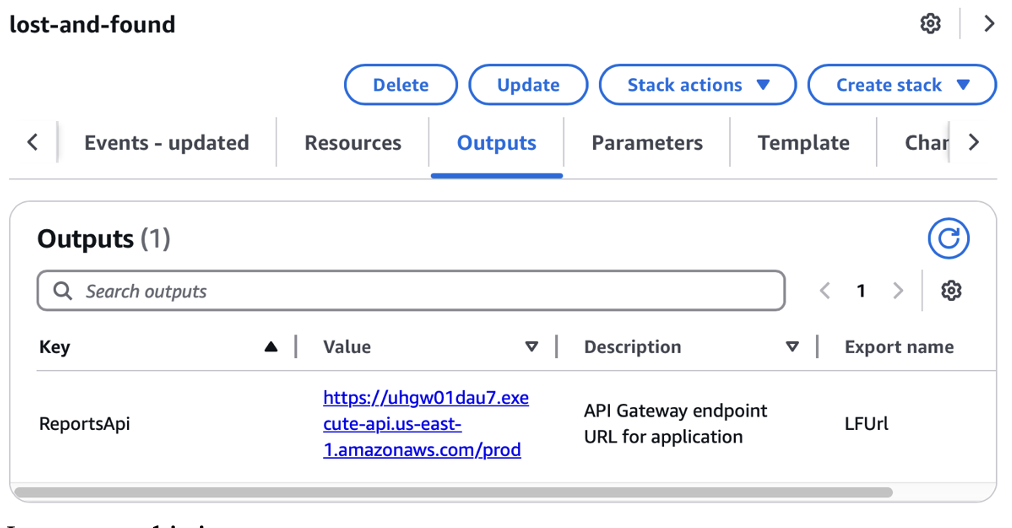
Testing
All tests were successful!
User was able to successfully log in and subscribe to SNS topic
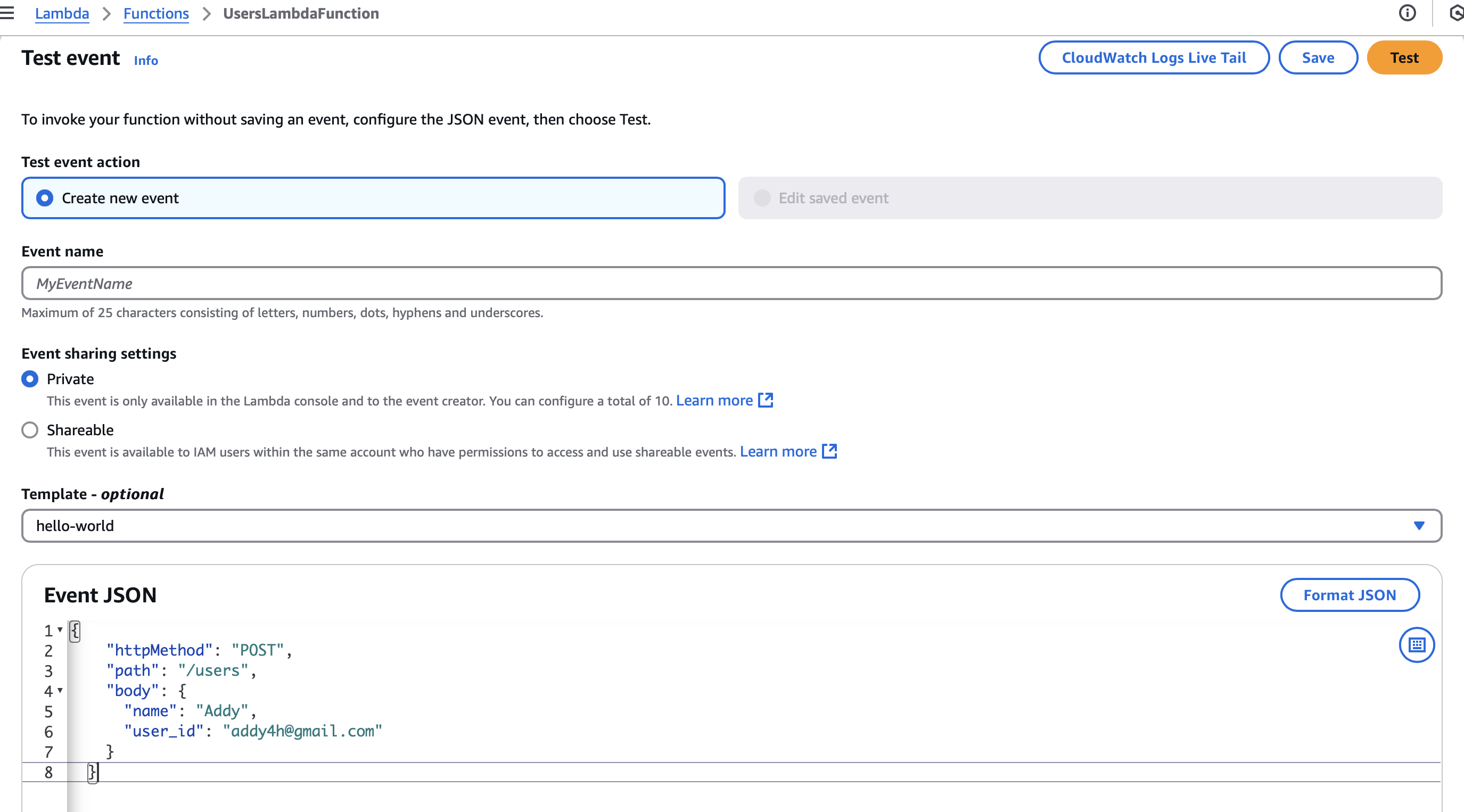
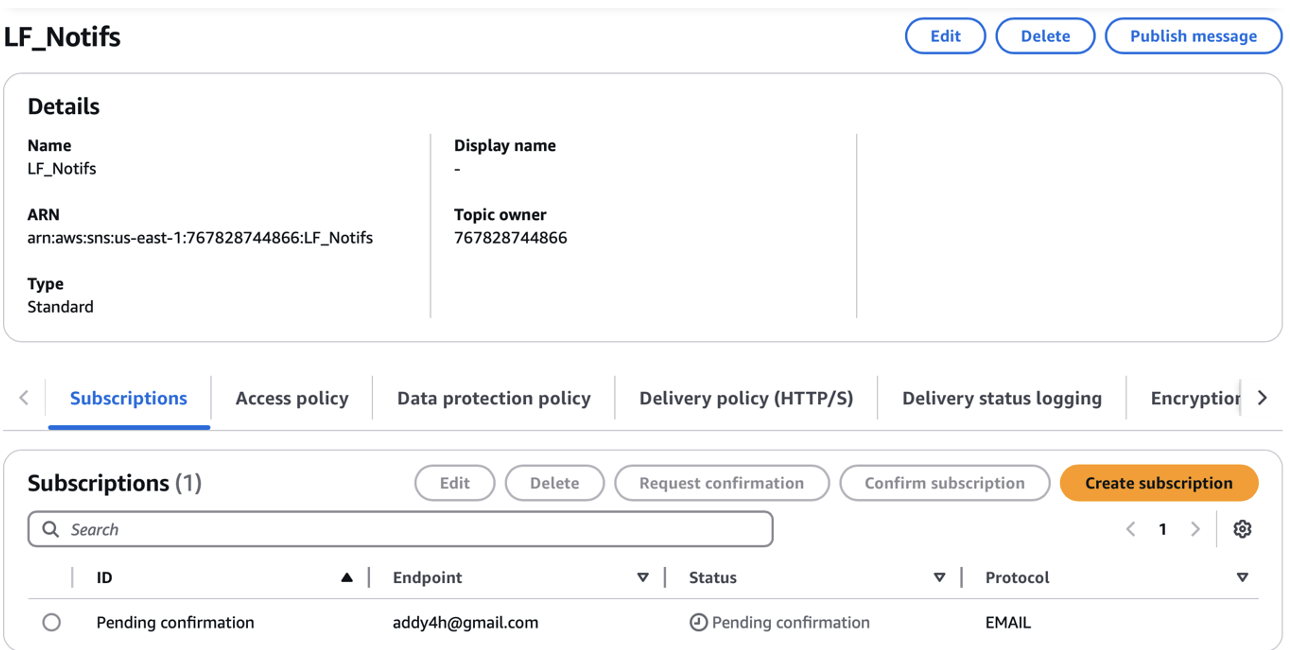

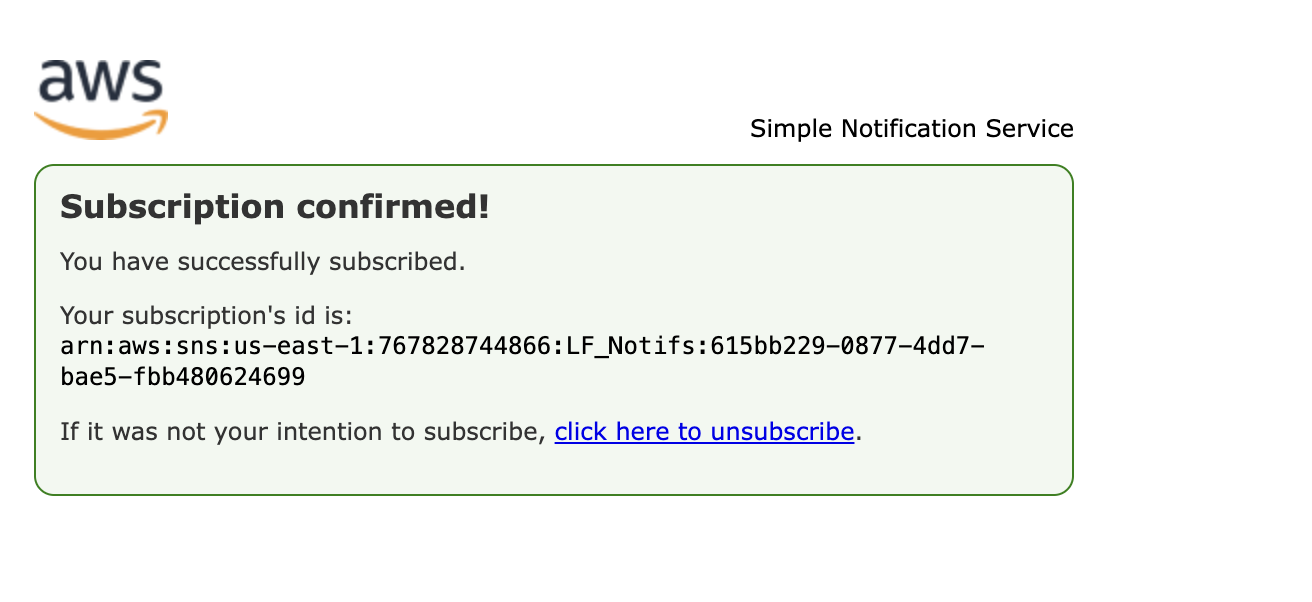
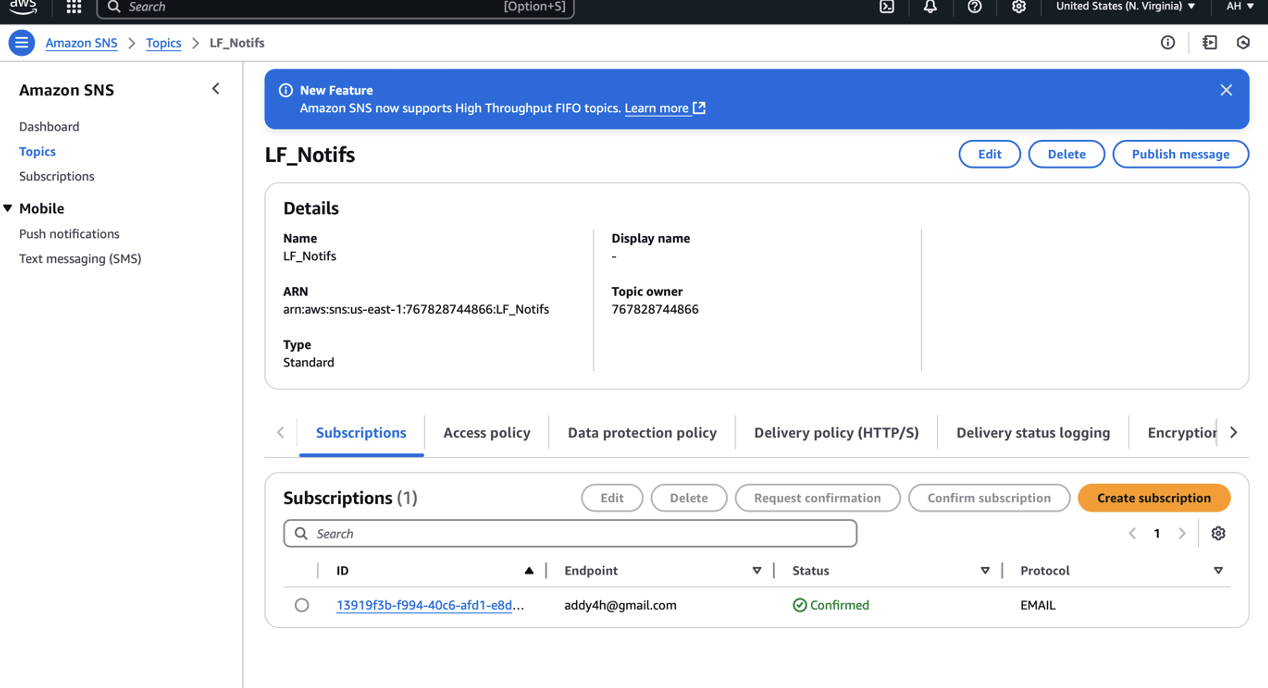
User successfully created a missing report
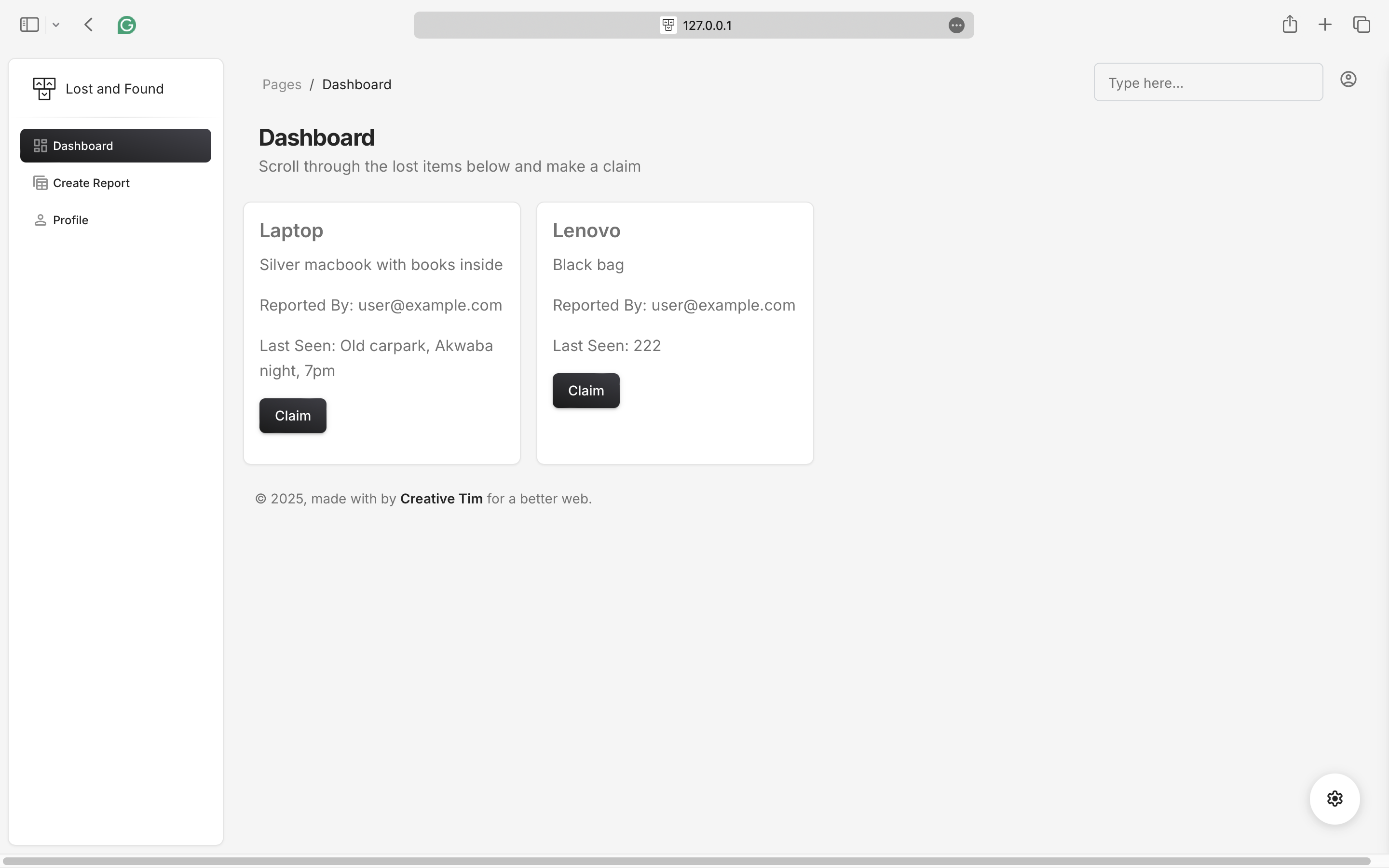
Dashboard only displays lost reports with new report created
User can claim reports
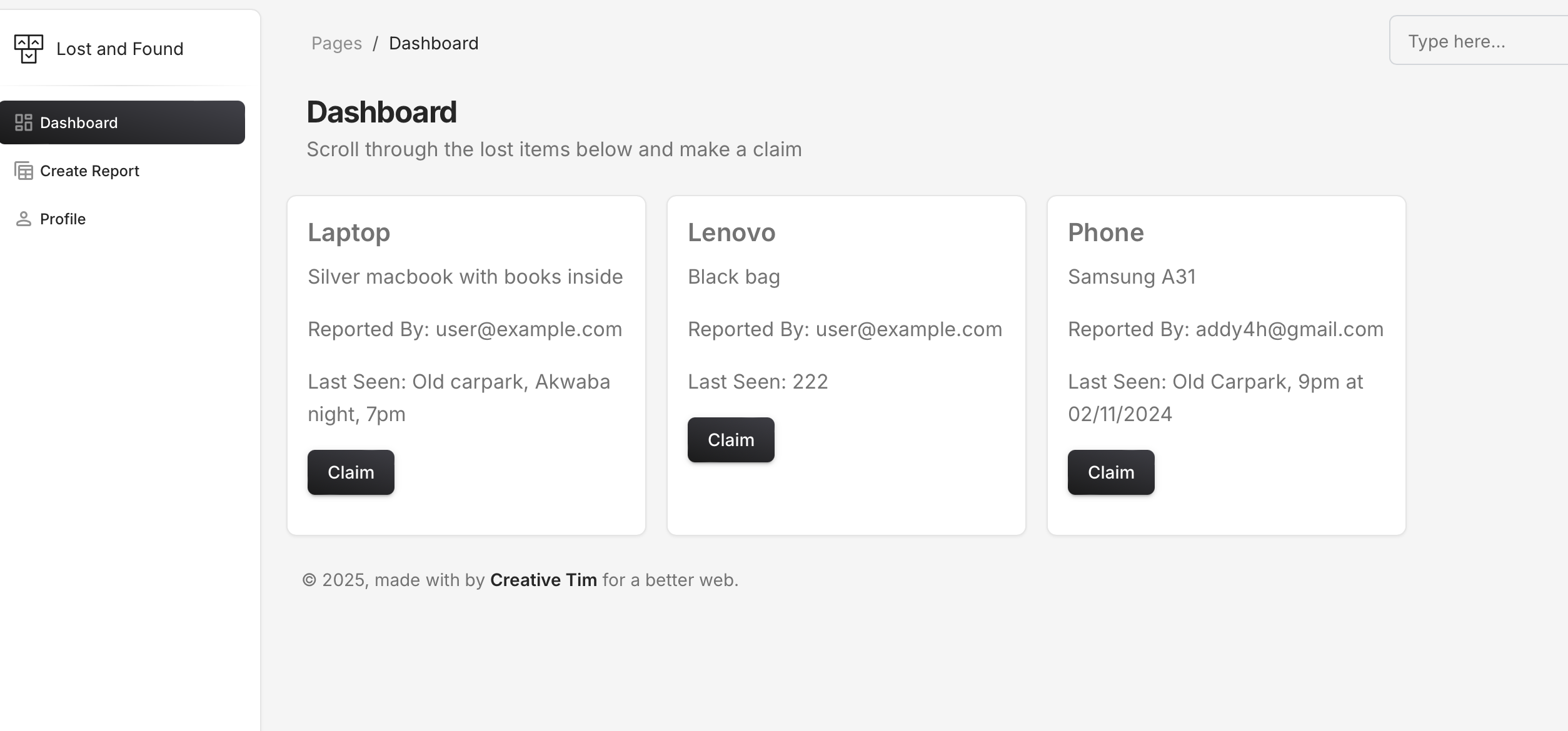
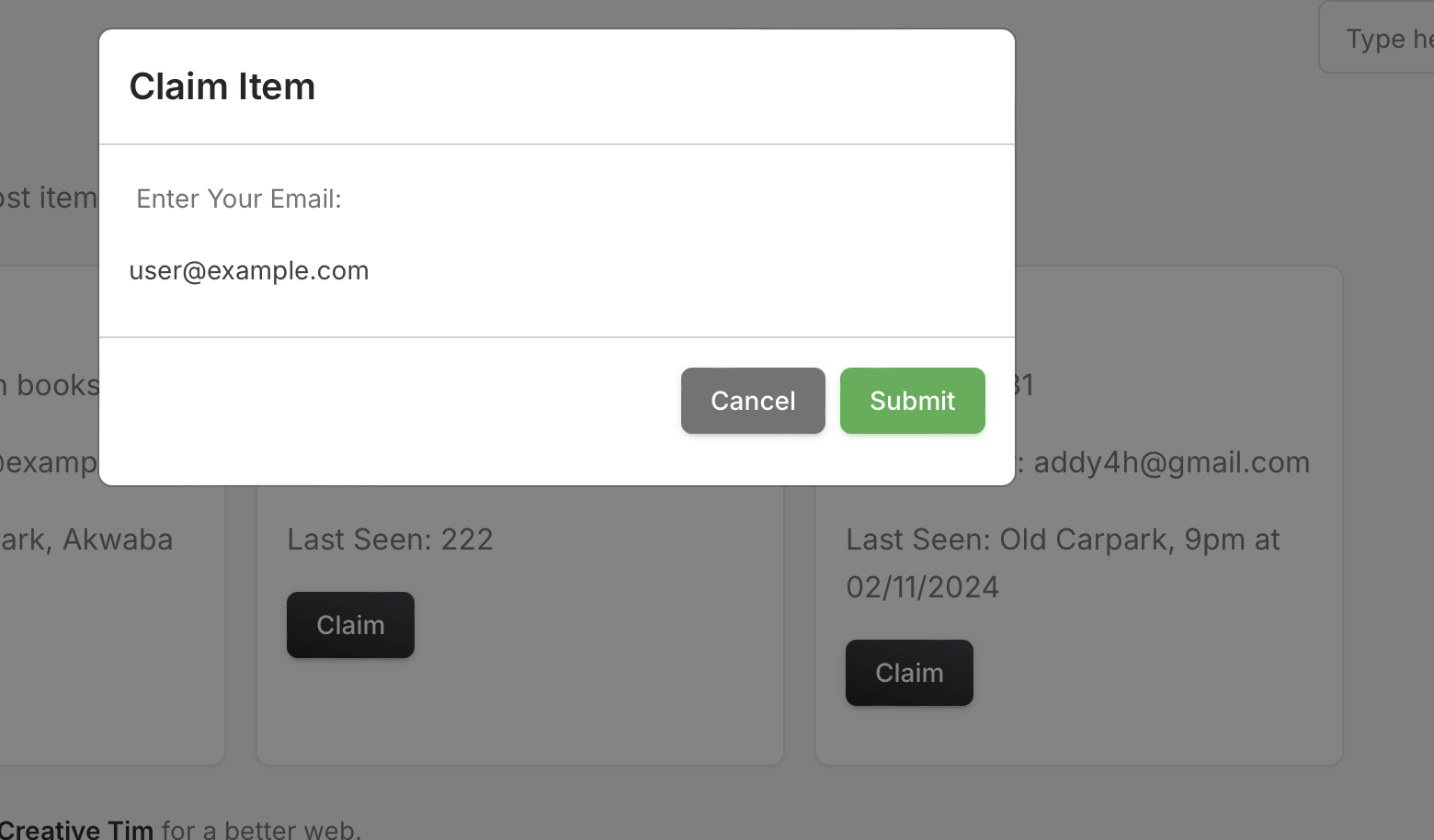
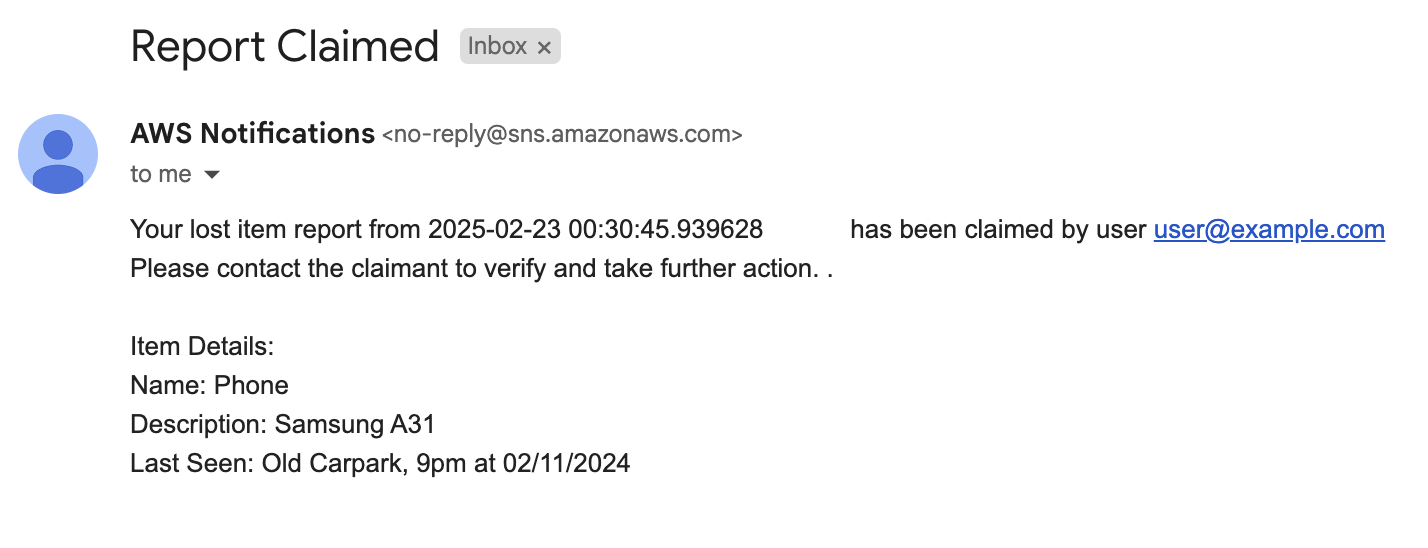
System finds potential match
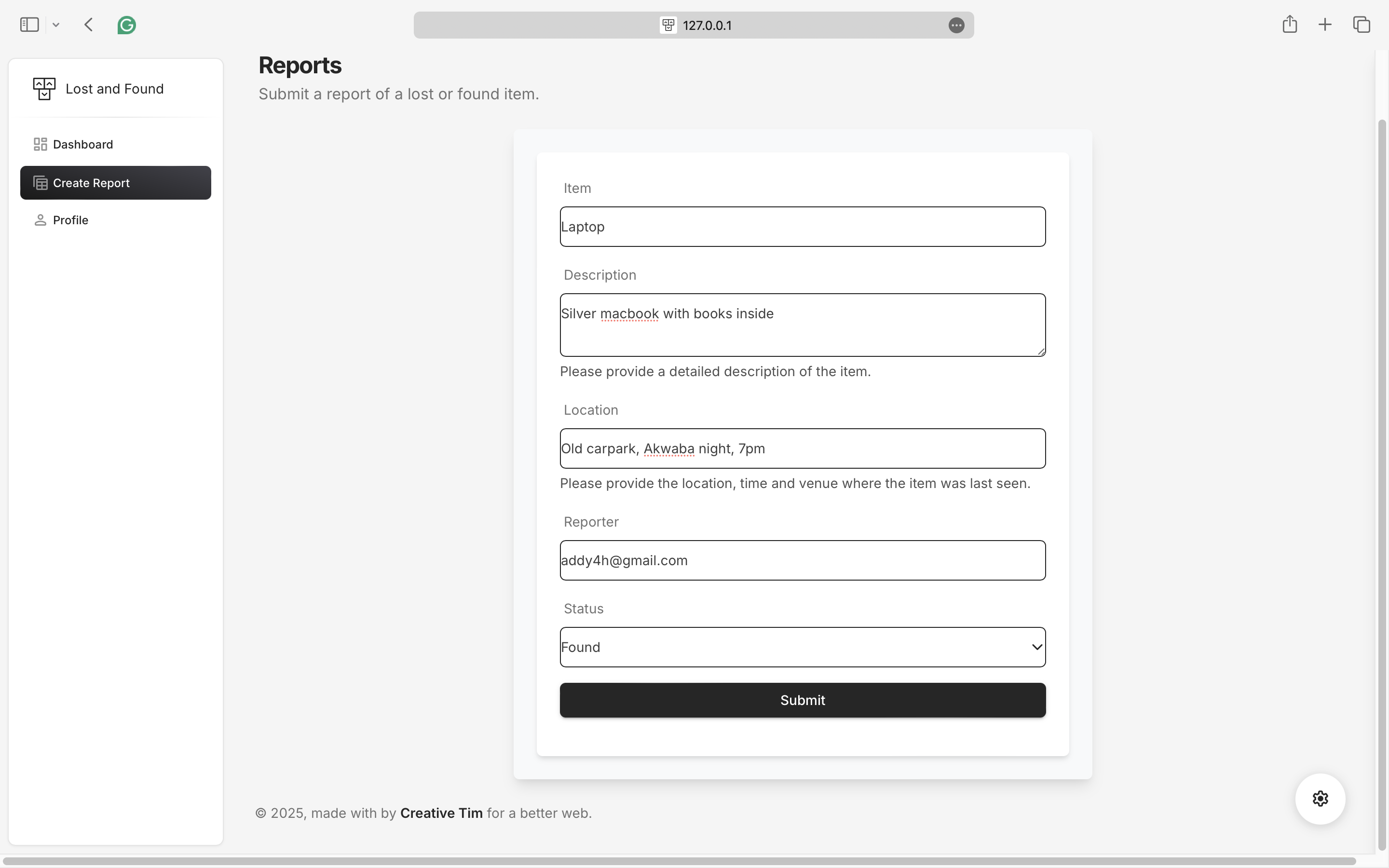
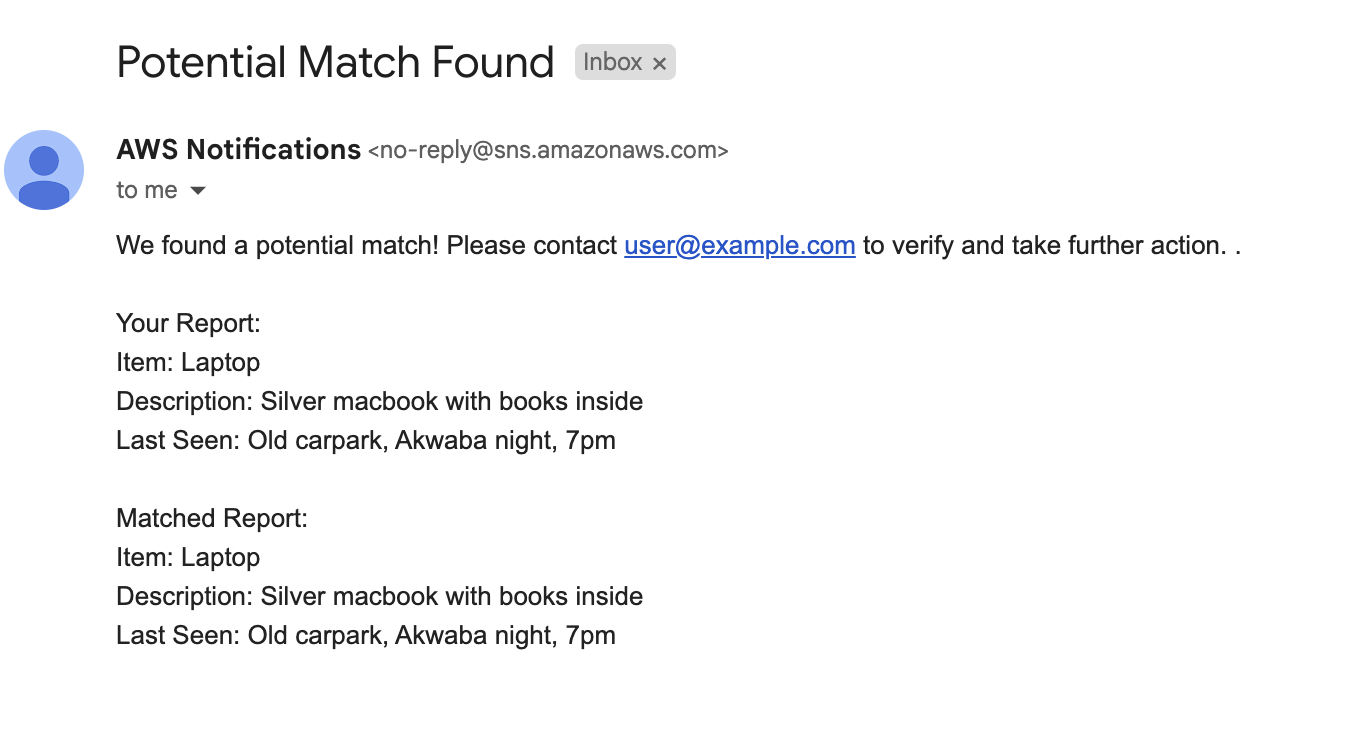
Conclusion
In this little example, we have shown how much AWS can automate the little things that we do. Future work may include validating/authenticating claiming members to enhance safety in the community. Another aspect is the use of AWS cognito to handle the user registration etc and additional check to clear lost claimed lost items only after the item has been retrieved
Here is the link to the full back end for the system
Thank you for reading. I hope you found your phone now!
Subscribe to my newsletter
Read articles from Adelle Hasford directly inside your inbox. Subscribe to the newsletter, and don't miss out.
Written by
